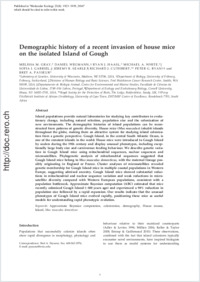Demographic history of a recent invasion of house mice on the isolated Island of Gough
- Gray, Melissa M. Laboratory of Genetics, University of Wisconsin, Madison, USA
- Wegmann, Daniel Biochemistry, Department of Biology, University of Fribourg, Switzerland
- Haasl, Ryan J. Laboratory of Genetics, University of Wisconsin, Madison, USA
- White, Michael A. Laboratory of Genetics, University of Wisconsin, Madison, USA - Divisions of Human Biology and Basic Sciences, Fred Hutchinson Cancer Research Center, Seattle, USA
- Gabriel, Sofia I. Departamento de Biologia Animal, Centre for Environmental and Marine Studies, Faculdade de Ciências da Universidade de Lisboa, Lisbon, Portugal
- Searle, Jeremy B. Department of Ecology and Evolutionary Biology, Cornell University, Ithaca, USA
- Cuthbert, Richard J. Royal Society for the Protection of Birds, The Lodge, Bedfordshire, Sandy, UK
- Ryan, Peter G. Percy FitzPatrick Institute of African Ornithology, University of Cape Town, Rondebosch, South Africa
- Payseur, Bret A. Laboratory of Genetics, University of Wisconsin, Madison, USA
-
01.04.2014
Published in:
- Molecular Ecology. - 2014, vol. 23, no. 8, p. 1923–1939
English
Island populations provide natural laboratories for studying key contributors to evolutionary change, including natural selection, population size and the colonization of new environments. The demographic histories of island populations can be reconstructed from patterns of genetic diversity. House mice (Mus musculus) inhabit islands throughout the globe, making them an attractive system for studying island colonization from a genetic perspective. Gough Island, in the central South Atlantic Ocean, is one of the remotest islands in the world. House mice were introduced to Gough Island by sealers during the 19th century and display unusual phenotypes, including exceptionally large body size and carnivorous feeding behaviour. We describe genetic variation in Gough Island mice using mitochondrial sequences, nuclear sequences and microsatellites. Phylogenetic analysis of mitochondrial sequences suggested that Gough Island mice belong to Mus musculus domesticus, with the maternal lineage possibly originating in England or France. Cluster analyses of microsatellites revealed genetic membership for Gough Island mice in multiple coastal populations in Western Europe, suggesting admixed ancestry. Gough Island mice showed substantial reductions in mitochondrial and nuclear sequence variation and weak reductions in microsatellite diversity compared with Western European populations, consistent with a population bottleneck. Approximate Bayesian computation (ABC) estimated that mice recently colonized Gough Island (~100 years ago) and experienced a 98% reduction in population size followed by a rapid expansion. Our results indicate that the unusual phenotypes of Gough Island mice evolved rapidly, positioning these mice as useful models for understanding rapid phenotypic evolution.
- Faculty
- Faculté des sciences et de médecine
- Department
- Département de Biologie
- Language
-
- English
- Classification
- Biological sciences
- License
-
License undefined
- Identifiers
-
- RERO DOC 209929
- DOI 10.1111/mec.12715
- Persistent URL
- https://folia.unifr.ch/unifr/documents/303426
Other files
Statistics
Document views: 95
File downloads:
- pdf: 222
- Supplementary material: 135

